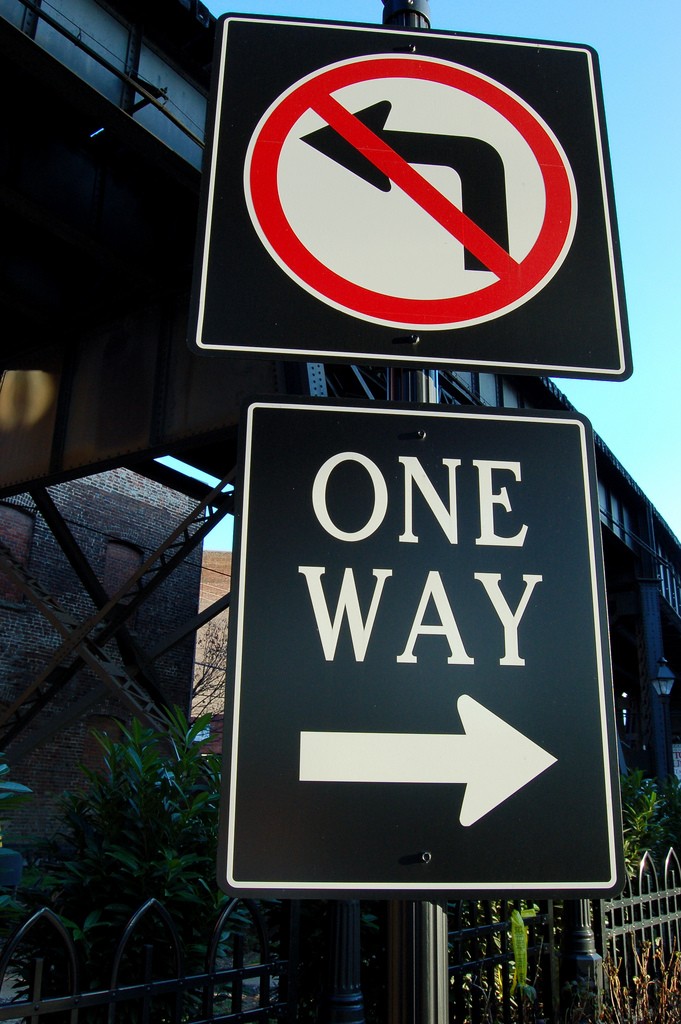
These signs are the bane of an urban cyclist.
Photo by Taber Andrew Bain.
The butchering of Hamilton's street grid has to stop
Today, the inadequacies of postwar traffic engineering were unceremoniously laid bare as a power failure in downtown Hamilton forced thousands of people out of their office towers and onto the few arterial roads that traverse the lower city.
For those unfamiliar with Hamilton's traffic history, traffic engineers in the 1950s converted the lower city's main throughfares to one-way streets, in order to facilitate the movement of commuters from the Mountain to the steel factories at the waterfront. The one-way conversions succeeded in moving large amounts of traffic very efficiently - but only if that traffic was moving along a predetermined route. Traffic signal timing, lane widths, no-left-turn intersections - these were all engineered to create efficient vehicular flow. The problem is, if you feel like taking a different route or have a different destination in mind, good luck. Because the traffic gods will ensure that you get kicked back on to Main St. or King St.
Hamilton has a very old downtown core, with a tightly meshed street grid. However, since the 1950s, parts of that grid have become broken. Many of the smaller neighbourhood streets have been converted to one-way, and de facto dead-ends are littered throughout the lower city. Practically speaking, this means that you can't use Jackson Street, for example, to travel east-west because there's a dead end where it runs into City Hall's parking lot from both sides. Another example is King William Street. Travel far enough west, and you'll be confronted with an intersection that forbids you to go straight or turn left. The only option is to divert your route several blocks north to Cannon or Wilson, both major arterial roads.
The problem with funnelling all traffic onto a select few streets is that it doesn't take much for the city to grind to a halt. Using this model, the efficient flow of vehicles requires precise control of traffic signals and as few complications as possible. Something as simple as a power outage can throw the whole system into chaos.
Because there were no other viable routes out of the city, today's power failure forced everyone working downtown to simultaneously squeeze into four arterial roads: two going eastbound, two westbound. Even on my bike, which normally allows me to breeze past gridlock, I had to jump down the back of a parking lot and cut across City Hall and Victoria Park to rid myself of the congestion.
When I was eventually kicked back on to King Street by a dead-end, I spent a good half-minute watching an ambulance trying to break through a row of cars four lanes across and two vehicles deep. When emergency vehicles can't bypass the afternoon rush hour, that's a problem. Peoples' lives are at stake. Yes, this rush hour was especially bad because of the power outage (which forced everyone to leave at the same time), but it's exactly these kinds of crises where emergency services are needed the most.
I've studied the grid street network countless times, and I can spew all the rhetoric about how it dissipates congestion by providing alternate route options. I've heard Duany's lectures and I know the theory. But seeing it unfold so clearly in front of my eyes made me realise just how fragile the collector-arterial system really is.
It's one thing to build five-lane expressways through downtown Hamilton. It's quite another to butcher the streets around it so that everybody is forced to use that one road. Choice is essential in a functioning transportation network. That includes the choice to use alternate modes of transportation, but also to take a detour if you need to. As long as motorists and cyclists are punished for trying to avoid congestion, Hamilton's lower city will continue to be a traffic nightmare.
Sam Nabi